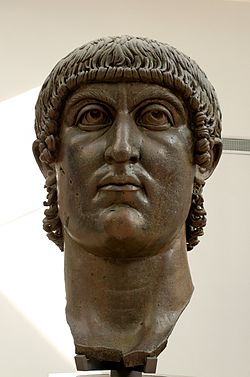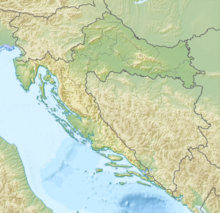TheBattle of Cibalaewas fought in 316[4]between the twoRoman emperorsConstantine I(r. 306–337) andLicinius(r. 308–324). The site of the battle, near the town ofCibalae(nowVinkovci,Croatia) in theRoman provinceofPannonia Secunda,was approximately 350 kilometers within the territory of Licinius. Constantine won a resounding victory, despite being outnumbered.
| Battle of Cibalae | |||||||
|---|---|---|---|---|---|---|---|
| Part ofCivil wars of the Tetrarchy | |||||||
 Constantine, bronze head from a sculpture, Capitoline Museums, Rome | |||||||
| |||||||
| Belligerents | |||||||
| Constantine the Great | Licinius | ||||||
| Commanders and leaders | |||||||
| Constantine | Licinius | ||||||
| Strength | |||||||
| 20,000[1][2] | 35,000[1][2] | ||||||
| Casualties and losses | |||||||
| Unknown | 20,000[3] | ||||||
Location within Croatia | |||||||
Background
editThe hostilities were prompted by Constantine's appointment of his brother-in-law,Bassianus,asCaesar.Bassianus was discovered to be intriguing against Constantine, perhaps at the prodding of his own brother Senecio, a close associate of Licinius. When Constantine demanded that Licinius hand over Senecio, Licinius refused. Constantine marched against Licinius, who responded by elevating another associate,Valens.[5]The date of Valens' elevation as emperor probably occurred after the Battle of Cibalae.
The unreliablefastiofHydatiusdates the battle to 8 October 314, but the remaining literary and numismatic evidence point to the battle being fought in 316.[6]
Battle
editThe opposing armies met on the plain between the riversSavaandDravanear the town of Cibalae (Vinkovci). The battle lasted all day. The battle opened with Constantine's forces arrayed in a defile adjacent to mountain slopes. The army of Licinius was stationed on lower ground nearer the town of Cibalae, Licinius took care to secure his flanks. As theinfantryof Constantine needed to move forward through broken ground, the cavalry was thrown out ahead, to act as a screen. Constantine moved his formation down on to the more open ground and advanced against the awaiting Licinians.[7]Following a period of skirmishing and intense missile fire at a distance, the opposing main bodies of infantry met in close combat and fierce hand-to-hand fighting ensued. This battle of attrition was ended, late in the day, when Constantine personally led a cavalry charge from the right wing of his army. The charge was decisive, Licinius' ranks were broken. As many as 20,000 of Licinius' troops were killed in the hard-fought battle. The surviving cavalry of the defeated army accompanied Licinius when he fled the field under the cover of darkness.[3]
Aftermath
editFollowing the battle Licinius was forced to flee toSirmium(Sremska Mitrovica,Serbia), and then, after collecting his family and treasury, toThrace.Peace negotiations were initiated, but they broke down. A further battle was then fought, theBattle of Mardia,which proved to be indecisive. Heavy losses were suffered by both sides. Following the battle, in expectation of Licinius retreating onByzantium,Constantine advanced in the direction of this city. However, Licinius had withdrawn northwards and this placed him across Constantine's lines of communication, Constantine also lost much of his baggage to Licinius.[3]A treaty highly favorable to Constantine was subsequently negotiated; this included the ceding by Licinius of the greater part of theBalkan Peninsulaand the elevation of Constantine's sons,Crispus(then about 14) andConstantine II(who was only an infant), with Licinius' young son (Licinius II), to the rank ofcaesar.Licinius then deposed and executed his erstwhile co-emperor Valens.[8]
Notes
edit- ^abLieu and Montserrat, p. 45.
- ^abGibbon, Decline and Fall of the Roman Empire, vol. I, chapter XIV, p. 439
- ^abcOdahl, p. 164
- ^For the consensus on dating of the battle of Cibalae in 316, see A.S. Christensen, L. Baerentzen,Lactantius the Historian,Museum Tusculanum Press, 1980, p. 23, W. Treadgold,A history of the Byzantine State and Society,Stanford University Press, 1997, p. 34, D.S. Potter, p. 378 and C. Odahl, p. 164. However, alternative years for the battle have been in debate since the 17th century; for the alternative dating at 314 see, among others,Ramsay MacMullen,Constantine,Routledge, reprinted 1987, p. 67 and A. H. M. Jones,Constantine and the Conversion of Europe,The English University Press, 1948, p. 127
- ^Grant (1993), pp. 42–43. Gaius Aurelius Valerius Valens was raised by Licinius to the position of Augustus in 316, following his defeat Licinius appeased Constantine by deposing and executing Valens.
- ^Barnes,pp. 36–38.
- ^Taylor, p. 87
- ^Stephenson, p. 166
References
edit- Barnes, Timothy D.(1973). "Lactantius and Constantine".Journal of Roman Studies.63:29–46.doi:10.2307/299163.
- Grant, Michael (1993),The Emperor Constantine,London.ISBN0-7538-0528-6
- Lieu, S.N.C and Montserrat, D. (Ed.s) (1996),From Constantine to Julian,London.ISBN0-415-09336-8
- Odahl, C.M., (2004)Constantine and the Christian Empire,Routledge 2004.ISBN0-415-17485-6
- Potter, David S.The Roman Empire at Bay AD 180–395,Routledge, 2004.ISBN0-415-10058-5
- Stephenson, P. (2009)Constantine: Unconquered Emperor, Christian Victor,Quercus, London.
- Taylor, D. (2016)Roman Empire at War: A Compendium of Roman Battles from 31 B.C. to A.D. 565,Pen and Sword, Barnsley.
